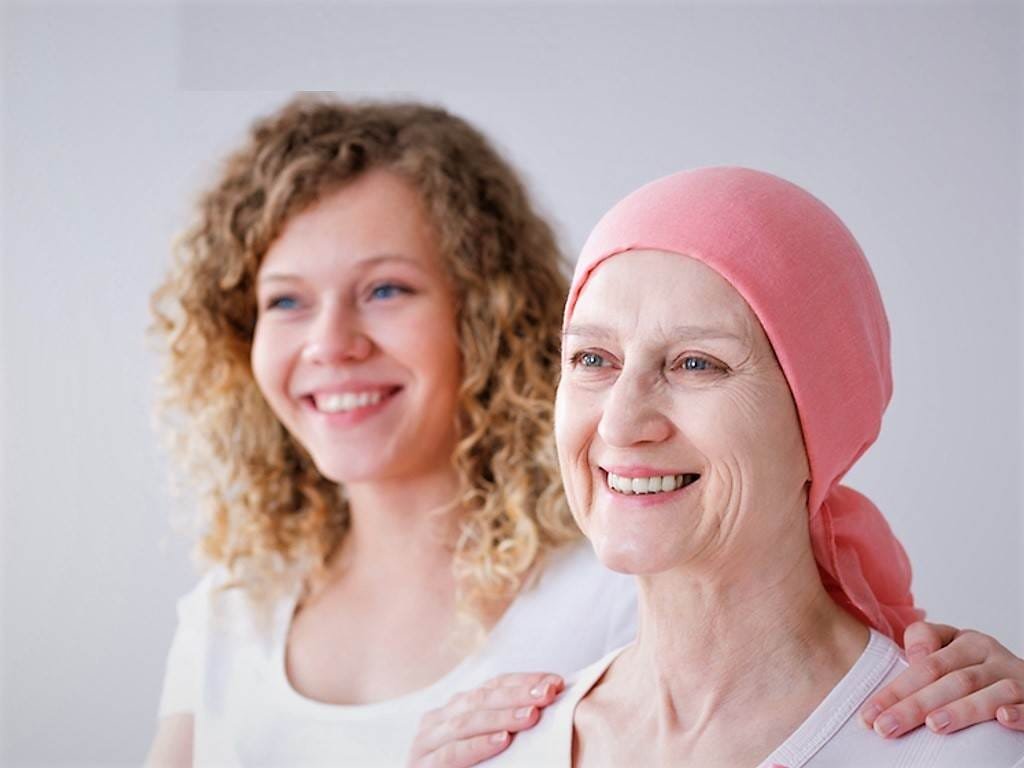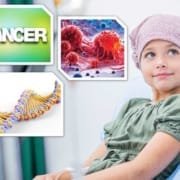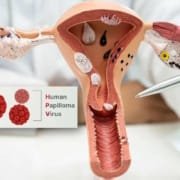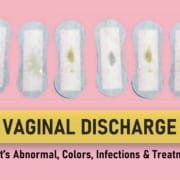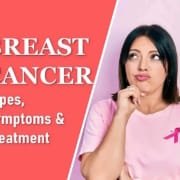Breast Cancer: Types, Symptoms, Causes & Diagnosis
What is Cancer ?
Cancer occurs when cells in the body undergo changes and proliferate uncontrollably. The body comprises of small building blocks known as cells. Normal cells grow when your body needs them, and die when your body does not need them any longer. Cancer comprises abnormal cells that continue to grow, even though the body does not require them. In most types of cancer, the abnormal cells grow to form a lump or mass called a tumor.
Understanding the Breast
The breast is made up of lobules and ducts. The lobules are the glands that are capable of producing milk. The ducts are thin tubes that carry the mother’s milk from the lobules to the nipple. The breast is also made of fat, connective tissue, lymph nodes, and blood vessels.
What is Breast Cancer ?
Breast cancer is cancer that starts in the breast. It occurs when cells in the breast are changed and start to grow out of control. The ducts and the lobules are the two parts of the breast where cancer is most likely to occur.
Breast cancer is one of the most common forms of cancer in women in the U.S. While its exact cause is still not known, once it develops, cancer cells can spread to other body parts, posing a life-threatening risk. Fortunately, breast cancer is frequently detected early, before it has a chance to spread.
Types of Breast Cancer
There are several types of breast cancer, including these more common types: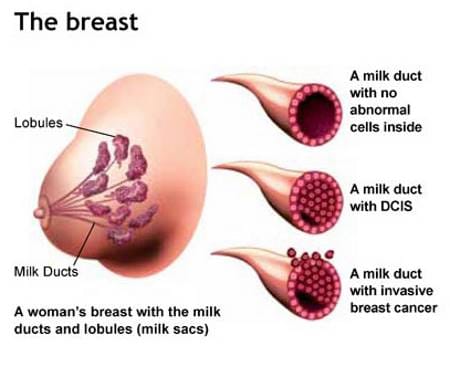
- Ductal carcinoma. This is the most common type and it begins in the lining of the milk ducts. When breast cancer remains confined within the ducts and hasn’t spread, it’s referred to as ductal carcinoma in situ (DCIS) or intraductal carcinoma. This represents the most common type of noninvasive breast cancer. Invasive ductal carcinoma is breast cancer that has spread beyond the walls of the breast ducts. It’s the most common type of invasive breast cancer.
- Invasive Lobular carcinoma. This type starts in the milk producing glands (lobules) and spreads outside the lobules.
- Paget disease. This is a rare type of breast cancer that originates in the glands within or beneath the skin. It typically progresses slowly and is often not diagnosed and treated until it has advanced. It occurs in only one nipple, and causes symptoms that are like a skin infection, such as inflammation, redness, oozing, crusting, itching, and burning.
- Inflammatory breast cancer. This is a rare form of invasive breast cancer. Usually there is no lump or tumor. Instead, this cancer manifests with redness and warmth in the skin of the breast. The affected skin may also appear thick and dimpled, resembling an orange peel. In its initial stages, inflammatory breast cancer is often mistaken for a breast infection known as mastitis.
- Triple negative breast cancer. This is a subtype characterized by the absence of estrogen receptors, progesterone receptors, and an excess of the HER2 protein on the surfaces of cancer cells. It is more prevalent in younger women and African-American women. This type of breast cancer tends to exhibit rapid growth and spread compared to most other types.
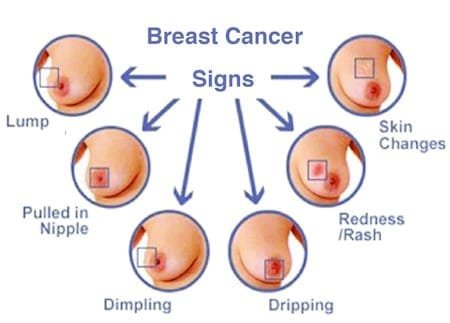
Symptoms of Breast Cancer
Breast cancer can present itself in various ways. Some symptoms are very distinctive, while others may simply make parts of your breast look different from the rest. It’s also possible to have breast cancer without noticeable symptoms. When symptoms do occur, they may include:
- Changes in Size, Shape, or Contour: Alterations in the overall appearance of your breast.
- Mass or Lump: A lump that may be as small as a pea.
- Persistent Lump or Thickening: A lump or thickened area in or near your breast or underarm that persists through your menstrual cycle.
- Hardened Area: A marble-like hardened area under your skin.
- Skin Changes: The skin on your breast or nipple may appear dimpled, puckered, scaly, or inflamed, and may look red, purple, or darker than the surrounding skin.
- Nipple Discharge: Blood-stained or clear fluid discharge from your nipple.
Causes of Breast Cancer
Breast cancer occurs when breast cells mutate and become cancerous, dividing and multiplying to form tumors. The exact trigger for these changes is not fully understood, but research has identified several risk factors that may increase the likelihood of developing breast cancer:
- Age: Being 55 or older increases the risk.
- Sex: Women and people assigned female at birth (AFAB) are much more likely to develop breast cancer than men and people assigned male at birth (AMAB).
- Family History: Having close relatives (parents, siblings, children) with breast cancer increases your risk.
- Genetics: Up to 15% of breast cancer cases are due to inherited genetic mutations, particularly in the BRCA1 and BRCA2 genes.
- Obesity: Being overweight can contribute to the development of breast cancer.
- Alcohol Consumption: Drinking alcohol may increase the risk of breast cancer.
- Smoking: Tobacco use is linked to various types of cancer, including breast cancer.
- Radiation Exposure: Previous radiation therapy, especially to the head, neck, or chest, increases the risk.
- Hormone Replacement Therapy (HRT): Using HRT is associated with a higher risk of breast cancer.
If you notice any symptoms or have concerns about breast cancer, it’s important to see your doctor promptly. Early detection and treatment can significantly improve outcomes.
How Breast Cancer Spreads ?
Breast cancer can spread by growing into nearby tissues in the breast or when the cancer cells get into and travel through the blood or lymph systems. When this happens, cancer cells may be found in the lymph nodes in the armpit. These lymph nodes are called axillary lymph nodes. They are often checked for cancer as part of the diagnosis process. If the cancer reaches these nodes, it may have spread to other parts of the body.
Breast cancer that has metastasized to other organs of the body is referred to as metastatic breast cancer. When breast cancer metastasizes, it frequently affects the brain, bones, liver, or lungs.
The crucial aspect in assessing breast cancer is identifying its:
- Noninvasive (in situ) cancer. This occurs only in the ducts or lobules and doesn’t spread to nearby areas. If not treated, it can later grow into a more serious, invasive type of cancer. If you are diagnosed with noninvasive carcinoma, your chances of surviving are very high if you don’t wait to treat it. If you do wait, you’re at risk of the cancer becoming invasive. Invasive cancer is harder to treat.
- Invasive (infiltrating) cancer. This kind of cancer has started to spread to nearby areas. This type is much more serious than noninvasive cancer. It often invades nearby lymph nodes first. It can then spread to other parts of your body through your bloodstream and lymphatic system. Treatment for invasive cancer is usually a more difficult, long-term process.
Breast Cancer Early Detection and Diagnosis
Breast cancer is sometimes found after symptoms appear, but many women with breast cancer have no symptoms. This is why regular breast cancer screening is so important.
Imaging Tests to Find Breast Cancer
Different tests can be used to look for and diagnose breast cancer. If your doctor finds an area of concern on a screening test (a mammogram), or if you have symptoms that could mean breast cancer, you will need more tests to know for sure if it’s cancer.
- Mammograms
- Breast Ultrasound
- Breast MRI Scans
- Newer and Experimental Breast Imaging Tests
Biopsy
A biopsy is done when mammograms, other imaging tests, or a physical exam shows a breast change that may be cancer. A biopsy is the only way to know for sure if it’s cancer.
Tests to look for breast cancer spread
If your doctor suspects your cancer may have spread to other parts of your body, you may need more tests, such as chest x-rays, CT scans, bone scans, PET scans, or MRI scans.
Finding breast cancer during pregnancy
Breast cancer during pregnancy is rare. But if you find a lump or notice any unusual changes in your breasts that concern you, tell your doctor or nurse right away.
Talking with your healthcare provider
If you have questions about breast cancer, talk with your healthcare provider. Your healthcare provider can help you understand more about this cancer.

